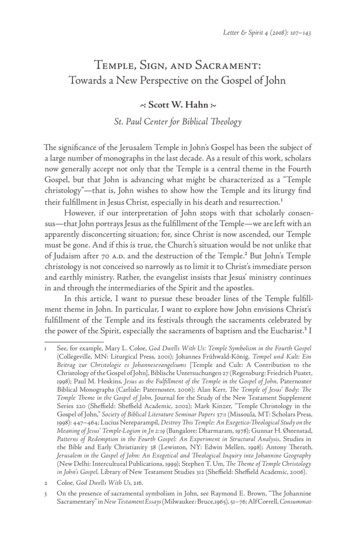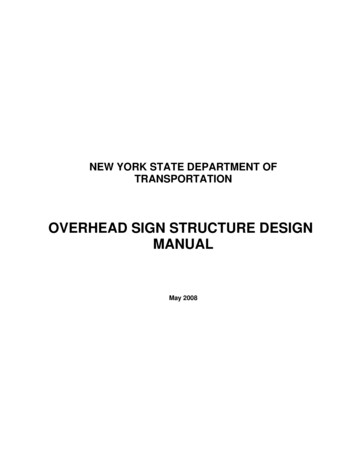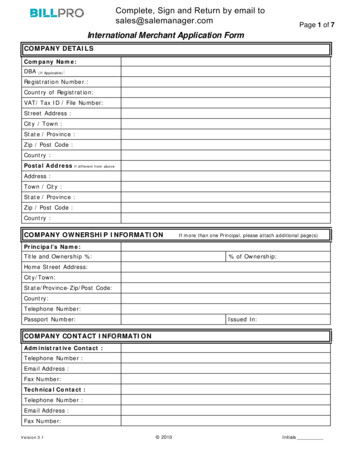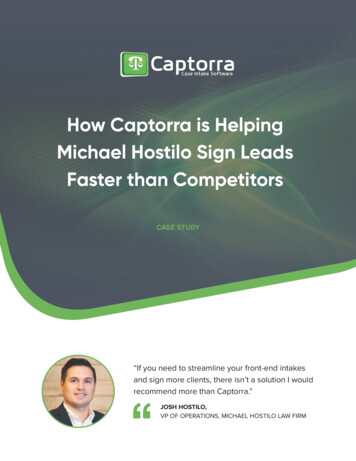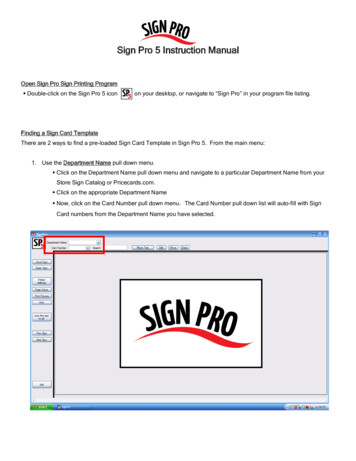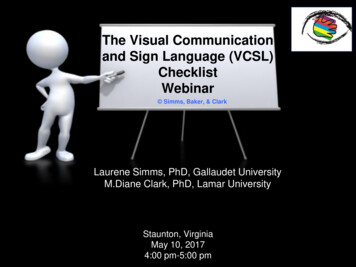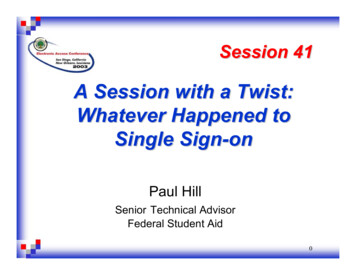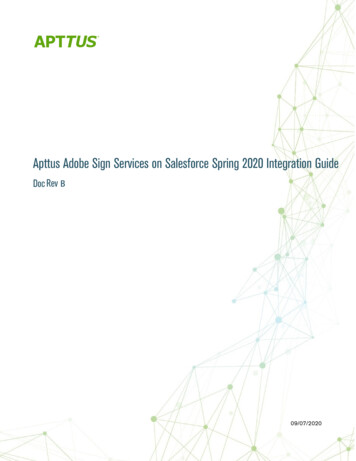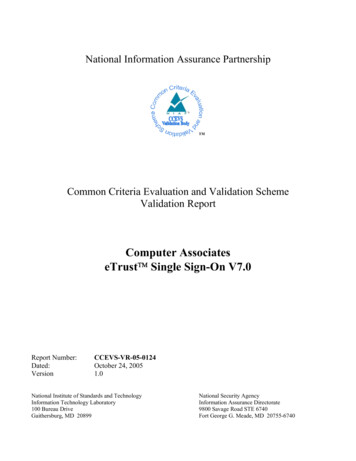
Transcription
50SIGN 50A guideline developer’s handbookRevised editionNovember 2011
NHS Quality Improvement Scotland (NHS QIS) is committed to equality and diversity. Thisguideline has been assessed for its likely impact on the six equality groups defined by age, disability,gender, race, religion/belief, and sexual orientation.For the full equality and diversity impact assessment report please see the “published guidelines”section of the SIGN website at www.sign.ac.uk/guidelines/published/numlist.html. The full reportin paper form and/or alternative format is available on request from the NHS QIS Equality andDiversity Officer.
Scottish Intercollegiate Guidelines NetworkSIGN 50A guideline developer’s handbookJanuary 2008
SIGN 50: A GUIDELINE DEVELOPER’S HANDBOOK Scottish Intercollegiate Guidelines NetworkISBN 978 1 905813 25 4First published 2008Revised November 2011SIGN consents to the photocopying of this guideline for thepurpose of implementation in NHSScotlandScottish Intercollegiate Guidelines NetworkElliott House, 8 -10 Hillside CrescentEdinburgh EH7 5EAwww.sign.ac.ukb
CONTENTSContents123SECTION 3.4 UPDATEDNOVEMBER 2011456Introduction.21.1Clinical guidelines and SIGN. 21.2Aim and structure of this manual. 21.3Guidelines in context. 31.4Medico-legal implications of SIGN guidelines. 41.5Review and updating of this manual. 5Organisation of guideline development.62.1The Scottish Intercollegiate Guidelines Network. 62.2Funding for guideline development. 102.3Timescale for guideline development. 102.4Influence of financial and other interests. 11Selection of guideline topics.123.1The SIGN programme. 123.2Criteria for selection of topics. 123.3Topic selection process. 123.4Updating published guidelines. 16Involving patients and their representatives.194.1Patient involvement in guideline development. 194.2Identifying patients’ views. 194.3Recruitment of patients to guideline development groups. 214.4Role of patient representatives on guideline development groups. 214.5Support for patient representatives on guideline development groups. 224.6Wider consultation with patients and carers. 22The guideline development group.235.1Composition of the guideline development group. 235.2Responsibilities of development group members. 25Systematic literature review.286.1Addressing patient issues in the literature search. 286.2Using existing guidelines. 286.3Defining key questions. 296.4Identifying and selecting the evidence. 306.5Evaluating the evidence. 32c
SIGN 50: A GUIDELINE DEVELOPER’S HANDBOOK789Forming guideline recommendations.347.1Synthesising the evidence. 347.2Considered judgement. 357.3Levels of evidence and grades of recommendation. 367.4Resource implications. 367.5Current areas for development. 37Consultation and peer review.388.1National open meeting. 388.2Peer review. 38Presentation and dissemination.409.1Content and presentation of the guideline. 409.2Recommendations for research. 409.3Quick reference guides and key messages. 419.4Electronic publishing. 419.5Information for patients. 419.6Dissemination. 419.7Links with audit. 4210 Implementation.4310.1 Getting guidelines into practice. 4310.2 identifying barriers to implementation. 4310.3 Implementation initiatives. 4310.4 Practical steps. 4410.5 Monitoring implementation. 47Annexes. 48References. 103
1 INTRODUCTIONMeeting the agree appraisal criteriaSIGN methodology complies with the criteria used by the AGREE (Appraisal of Guidelines forResearch and Evaluation in Europe) to identify good quality guidelines. The chapters of thismanual that describe how SIGN addresses each criterion are identified below.SIGN 50chapterScope and purpose1.2.The overall objective(s) of the guideline should be specifically described.The clinical question(s) covered by the guideline should be specifically described.9.16.33.The patients to whom the guideline is meant to apply should bespecifically described.9.1Stakeholder involvement4.The guideline development group should include individuals from all therelevant professional groups.55.The patients’ views and preferences should be sought.4Rigour of development6.7.8.Systematic methods should be used to search for evidence.6The criteria for selecting the evidence should be clearly described.6.3, 6.4The methods used for formulating the recommendations should be clearly7.1described.9.The health benefits, side effects and risks should be considered informulating the recommendations.7.210.There should be an explicit link between the recommendations and thesupporting evidence.7.211.The guideline should be externally reviewed by experts prior topublication.8.212.A procedure for updating the guideline should be provided.3.4Clarity of presentation13.14.The recommendations should be specific and unambiguous.The different options for diagnosis and/or treatment of the conditionshould be clearly presented.15.Key recommendations should be easily identifiable.9.19.17.2.3Applicability16.17.The target users of the guideline should be clearly defined.The potential organisational barriers in applying the recommendationsshould be discussed.9.11018.The potential cost implications of applying the recommendations shouldbe considered.The guideline should be supported with tools for application.The guideline should present key review criteria for monitoring and auditpurposes7.419.20.21.The guideline should be piloted among end users.109.1, 9.78.1Editorial independence22.23.The guideline should be editorially independent from the funding body.Conflicts of interest of guideline development members should berecorded.1.12.41
SIGN 50: A GUIDELINE DEVELOPER’S HANDBOOK1Introduction1.1Clinical guidelines and SIGNThe Scottish Intercollegiate Guidelines Network (SIGN) was established in 1993 by the Academyof Royal Colleges and their Faculties in Scotland, to develop evidence based clinical guidelinesfor the National Health Service in Scotland.1,2 Since January 2005, SIGN has been part of NHSQuality Improvement Scotland, though under the transfer agreement with the Academy SIGNretains editorial independence in relation to the guidelines it produces.Clinical practice guidelines have been defined as “systematically developed statements toassist practitioner and patient decisions about appropriate health care for specific clinicalcircumstances”.3 They are designed to help practitioners assimilate, evaluate and implement theever increasing amount of evidence and opinion on best current practice. Clinical guidelines areintended as neither cookbook nor textbook but, where there is evidence of variation in practicewhich affects patient outcomes and a strong research base providing evidence of effectivepractice, guidelines can assist healthcare professionals in making decisions about appropriateand effective care for their patients.The accepted criteria for validity of guidelines have evolved from the ‘essential elements of goodguidelines’ identified by the US Institute of Medicine in 1990.3 These recommended ‘attributesof good guidelines’ included validity, reliability, clinical applicability, clinical flexibility, clarity,multidisciplinary process, scheduled review, and documentation. The recommendations wereunderpinned by the twin themes of credibility and accountability: “The link between a set ofguidelines and the scientific evidence must be explicit, and scientific and clinical evidenceshould take precedence over expert judgement.” SIGN’s original Criteria for Appraisal ofClinical Guidelines for National Use,4 and the more recent AGREE (Appraisal of Guidelines,Research and Evaluation for Europe) guideline appraisal instrument5 are based on these foundingprinciples of guideline development.The AGREE criteria are reproduced in the introductory material to this manual, with links tothose manual chapters that explain how SIGN addresses each criterion. The only area whereSIGN does not comply with the AGREE criteria is in relation to the piloting of guidelines. Thefull appraisal instrument can be downloaded from the AGREE website: www.agreetrust.org1.2Aim and structure of this manualThis is the third revision of SIGN 50, previous versions having been issued in 2002 and 2004.SIGN methodology has continued to develop and since the previous version of this manual therehave been significant developments in the procedures for reviewing guidelines, the involvementof patients and carers, and extending the range of evidence considered.The principal aim of this manual is to provide a reference tool that may be used by individualmembers of guideline development groups as they work through the development process.Guidelines are intended for use by healthcare practitioners who are inevitably busy, with limitedtime available to read publications such as guidelines. Rather than overload every guidelinewith methodological details, SIGN 50 outlines the key elements of the development processcommon to all SIGN guidelines. Only where aspects of the topic under consideration requirea variation from the standard process will these be reported in the guidelines themselves.Guideline developers have an increasing obligation to be transparent about the methods theyhave used to develop their guideline. A secondary aim of this manual is to allow users to seehow SIGN guidelines are developed, and instil confidence that the potential biases of guidelinedevelopment have been addressed adequately, and that the recommendations are both internallyand externally valid, and feasible for practice.SIGN 50 is structured to follow the guideline development process from beginning to end,taking each step in turn. It starts with the context of guideline development in Scotland, andprogresses from first proposal of a new topic to final publication and implementation of theguideline. Hyperlinks are provided in the text to guide the user to related topics where thereis overlap between different chapters.2
1 INTRODUCTION1.3Guidelines in contextGuideline development, implementation, and review should be seen not as a linear process,but as a cycle of interdependent activities. These in turn are part of a range of complementaryactivities to translate evidence into practice, set and monitor standards, and promote clinicalexcellence in NHSiS, as illustrated in Figure 1.Figure 1: Guideline and audit ionReviewStandard setting andservice accreditationGuidelinesDevelopmentHealth TechnologyAssessmentClinical auditResearch anddevelopmentGuidelines frequently look at medicines, interventions and technologies that are also the subjectof individual review with authorities responsible for approving their use in the NHS. In thisrespect SIGN takes account of the reviews carried out by the Scottish Medicines Consortium(SMC) and the National Institute for Health and Clinical Excellence (NICE). The close relationshipbetween SIGN and other parts of NHS Quality Improvement Scotland facilitates these processes.The highest standards of patient care and improved outcomes are the ultimate goal.Guidelines can achieve better treatment outcomes and care for patients, but local ownershipof the implementation process is crucial to success in changing practice. For this reason, SIGNis responsible for the development of national guidelines and their implementability, but notdirectly for their implementation into practice. This is a responsibility of each individual NHSBoard, and is now reinforced by the twin ‘levers’ of clinical governance and the standardsetting and review components of NHS Quality Improvement Scotland. However, there is arole for national facilitation of local guideline implementation activities, and this is discussedin Chapter 10.Links with local and national audit projects are also an essential part of guideline implementation,and SIGN has been working closely with the Information and Statistics Division (ISD) to developthe audit component of guidelines and, where possible, to develop minimum datasets to facilitateprospective audit. This is discussed in Chapter 9.3
SIGN 50: A GUIDELINE DEVELOPER’S HANDBOOK1.4Medico-legal implications of SIGN guidelinesThe potential medico-legal implications of clinical guidelines have been of ongoing concernto medical practitioners since the establishment of a Scottish national guideline developmentprogramme was first proposed. Dr Pamela Abernethy of Simpson and Marwick WS, one ofthe leading Scottish experts on medical negligence, provided an initial paper on the legalimplications of guidelines to SIGN and NHS Scotland in December 1995.6 In this paper sheconcluded that clinical guidelines do not rob clinicians of their freedom, nor relieve them oftheir responsibility to make appropriate decisions based on their own experience and accordingto the particular circumstances of each patient. It is stressed that the standard of care required bylaw derives from customary and accepted practice rather than from the imposition of practicesthrough clinical guidelines.Dr Abernethy refers to the 1955 case of Hunter v Hanley as establishing the standard of carerequired under Scottish Law and describes the three-step test used to establish the liability ofa healthcare professional where it is alleged that (s)he has deviated from normal practice. TheCentral Legal Office (CLO) advised SIGN in 20067 that the Hunter v Hanley test is still theappropriate test in Scotland for liability for clinical negligence, ie it must be established that thecourse the healthcare professional has adopted “is one which no professional man of ordinaryskill would have taken if he had been acting with ordinary care”. This test was developedfurther by the Bolam test, ie a healthcare professional is not guilty of negligence if “he hasacted in accordance with a practice accepted as proper by a responsible body of men skilledin that particular art”. A healthcare professional may therefore defend a charge of negligencewith evidence that (s)he acted in conformity with the practice accepted by another body ofopinion. The test applied by the Court is therefore based on what is actually done in practicerather than on a prescription of what should be done as proposed by guidelines.Dr Abernethy states also that customary and accepted practice will be established in courtby introduction of expert testimony. Although clinical guidelines will not be introduced as asubstitute for expert testimony, they may be referred to by an expert witness as evidence of suchcustomary and accepted practice. The CLO has advised SIGN that this is still the case.The Hunter v Hanley test has been developed since 1995 by the 1997 case of Bolitho v Cityand Hackney Health Authority. This case introduced a more critical approach to the evidencesupplied by expert witnesses and provided that where it can be demonstrated that professionalopinion is not capable of withstanding logical analysis, the judge would be entitled to determinethat the opinion was not reasonable or responsible.The CLO advice to SIGN following this case is that the opinions of medical experts may notbe regarded as final and authoritative.7 Although a defendant may present expert opinion thathis practice was sound, the judge may look at additional evidence to determine whether thepractice was in fact logical. It may be that evidence based guidelines will be referred to as partof that additional evidence and the court may require to know why such guidelines were notfollowed and the reasoning behind the decision not to follow them. There is consequently greaterpotential for clinical guidelines to have a greater role in identifying the standard of care.In addition to this legal development in the determination of the duty of care, the originsof some guidelines which have been produced since 1995 may be relevant in the futurein determining their legal status. There is an argument that some guidelines produced byorganisations such as SIGN and NICE could come to be regarded as authoritative guidance inview of the robust m
NHS Quality Improvement Scotland (NHS QIS) is committed to equality and diversity. This guideline has been assessed for its likely impa

